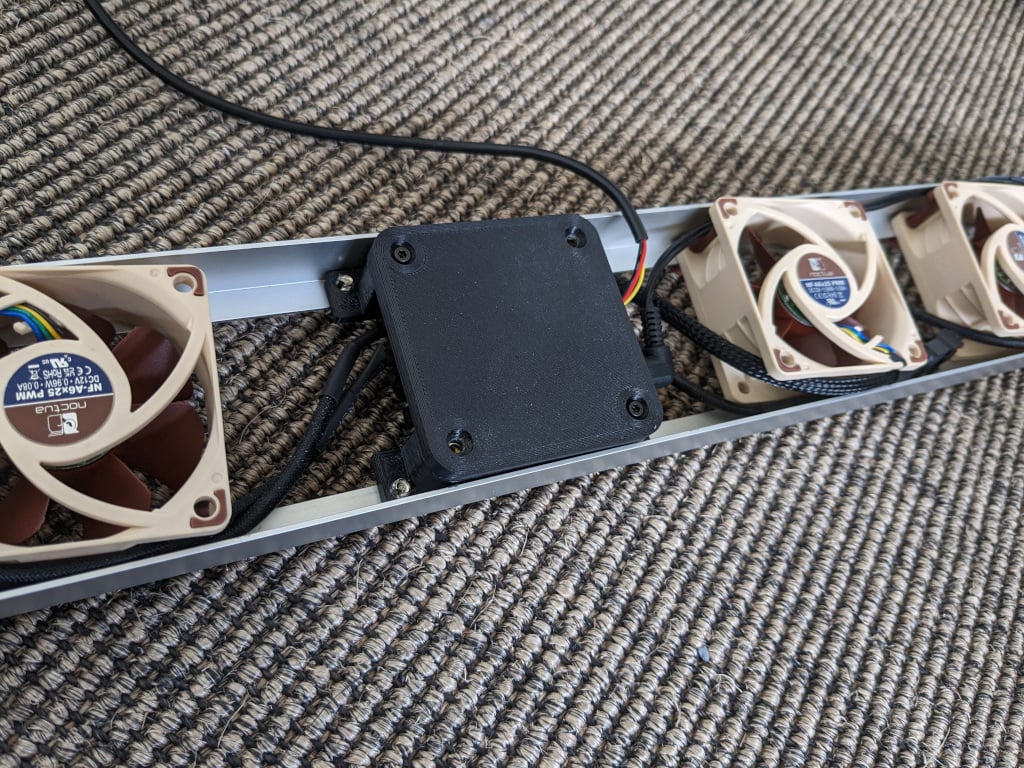
Wemos D1 Mini Heater fan controller
thingiverse
There is a large list of radiator fan mounting models * [Alvomane's Radiator Booster](https://www.thingiverse.com/thing:5856586) * [UppsalaHenrik's 2x92mm fan ducts for radiator](https://www.thingiverse.com/thing:3245743) * [djtifosi' Radiator Blower Fan with magnetic holder](https://www.thingiverse.com/thing:4432795) * [simlrh's Radiator Fan](https://www.thingiverse.com/thing:1279524) * [schranzistor's Radiator amplifier](https://www.thingiverse.com/thing:5036533) * [Edd77's Radiator Turbo for 12cm Fan](https://www.thingiverse.com/thing:2553775) * [Lord_Thoth's 90° funnel radiator, room heater 80mm fan mount](https://www.thingiverse.com/thing:4180096) * [Edd77's Radiator 115 Turbo for 12cm Fan](https://www.thingiverse.com/thing:2600327) * [serhero's Radiator Fan v2](https://www.thingiverse.com/thing:5605157) * [bjoerns1983's Radiator Fan](https://www.printables.com/model/400247-heizkorper-lufter-radiator-fan) * [Vcom's Radiator ventilator clip magnetic for 80mm fans](https://www.printables.com/model/277593-radiator-ventilator-clip-magnetic-for-80mm-fans) * [Jens Friedrich's Radiator Booster fan holder with magnets for 140mm inner width](https://www.printables.com/model/552901-radiator-booster-fan-holder-with-magnets-for-140mm) But there are no open PCBs to control the fans, read out temperatures and to monitor/control it over wifi. Instead of implementing everything from scratch, the ESP8266 based Wemos Lolin D1 mini v4.0 can be used. Only a simple IO board + enclosure had to be designed. It is responsible for: * Attaching a 12VDC (~1A) power supply * converting the 12V to 5V for the Wemos power supply * mounting the Wemos Lolin D1 mini v4.0 * attaching multiple DS18B20 based temperature sensors * enabling/disabling up to 4 12V fans (max 200mA recommended) There are two versions available. One with only through-hole components and one with mostly SMD components. The former is easier to assemble but the SMD version is also not too difficult. The PCB itself can be produced using the attached gerber files by [JLCPCB](https://jlcpcb.com/), [Aisler](https://aisler.net/), [PCBWay](https://www.pcbway.com/), [OSH Park](https://oshpark.com/), ... Please check the ibom.html inside the gerber zip files to get the list of components which need to be ordered for the PCB. The Wemos Lolin D1 mini v4.0 should be installed (while not being mounted to the PCB) using the [Tasmota Web Installer](https://tasmota.github.io/install/). After the installation finished, it has to be mounted on the PCB and configured via the devices' web interfaces (under Configuration): * Configuration Module: - Module Type: Generic (18) - D3 GPIO0: None - TX GPIO1: None - D4 GPIO2: None - RX GPIO3: Counter (1) - D2 GPIO4: PWM (1) - D1 GPIO5: Relay (1) - D6 GPIO12: DeepSleep - D7 GPIO13: DS18xS20 (1) - D5 GPIO14: None - D8 GPIO15: None - D0 GPIO16: None - A0 GPIO17: None * Configuration Timer: - Enable Timers: Yes - Enable (for each rule): Yes - Repeat (for each rule): Yes - Action (for each rule): Rule - (even rules are used to disable fans, odd rules are used to enable the temperature based fan control) * Console - Timezone according to [Tasmota's table](https://tasmota.github.io/docs/Timezone-Table/) - Activation rules (see below) - default settings ``` # Control with Dimmer/Color commands SetOption15 1 # Single Channel PWM SetOption68 0 # Set PWM frequency (25000 would be correct but Tasmota only has PWM_MAX set to 4kHz) PwmFrequency 4000 # Ensure PWM range is 0..1023 PWmRange 1023 ``` The rules are helpful to configure when the fans should be started. They need to be configured in the console: ``` # rule1 is used to control the fan based on the temperature rule1 on DS18B20#Temperature<34.5 do power1 off endon on DS18B20#Temperature>=35.0 do power1 on endon on DS18B20#Temperature>=45.0 do channel2 100 on break on DS18B20#Temperature>=40.0 do channel2 98 on break on DS18B20#Temperature>=35.0 do channel2 93 on endon # activate the rule1 rule1 on # rule2 disables/enables the first rule at specific times # the odd timers are used to enable rule1 # the eventtimers are used to disable rule1 + stop fans rule2 on Clock#Timer=1 do Rule1 1 endon on Clock#Timer=2 do Rule1 0 endon on Clock#Timer=2 do power1 off endon on Clock#Timer=3 do Rule1 1 endon on Clock#Timer=4 do Rule1 0 endon on Clock#Timer=4 do power1 off endon on Clock#Timer=5 do Rule1 1 endon on Clock#Timer=6 do Rule1 0 endon on Clock#Timer=6 do power1 off endon on Clock#Timer=7 do Rule1 1 endon on Clock#Timer=8 do Rule1 0 endon on Clock#Timer=8 do power1 off endon on Clock#Timer=9 do Rule1 1 endon on Clock#Timer=10 do Rule1 0 endon on Clock#Timer=10 do power1 off endon on Clock#Timer=11 do Rule1 1 endon on Clock#Timer=12 do Rule1 0 endon on Clock#Timer=12 do power1 off endon on Clock#Timer=13 do Rule1 1 endon on Clock#Timer=14 do Rule1 0 endon on Clock#Timer=14 do power1 off endon rule2 on ``` For the enclosure, a couple of extra parts need to be purchased: * 4x M2.5 Inserts * 4x M2.5 Screws
With this file you will be able to print Wemos D1 Mini Heater fan controller with your 3D printer. Click on the button and save the file on your computer to work, edit or customize your design. You can also find more 3D designs for printers on Wemos D1 Mini Heater fan controller.
